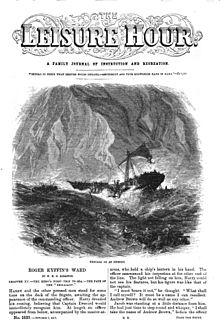 The cover of issue 1032, with an illustration accompanying a story about a shipwreck. | |
| Frequency | Weekly |
|---|---|
| Publisher | Religious Tract Society |
| First issue | January 1, 1852 |
| Country | United Kingdom |
| Based in | London |
| Language | English |
| OCLC | 362165421 |
The Leisure Hour was a British general-interest periodical of the Victorian era published weekly from 1852 to 1905.[1][2] It was the most successful of several popular magazines published by the Religious Tract Society, which produced Christian literature for a wide audience.[1] Each issue mixed multiple genres of fiction and factual stories, historical and topical.[1]
The magazine's title referred to campaigns that had decreased work hours, giving workers extra leisure time.[3] Until 1876, it carried the subtitle A Family Journal of Instruction and Recreation;[4] after that, the subtitle changed to An illustrated magazine for home reading.[5]
Each issue cost one penny and contained 16 pages.[6] The layout typically included approximately six long articles, formatted in two columns per page, and five or six illustrations. The articles were a mix of biographies, poetry, essays, and fiction. Each issue usually started with a piece of serialised fiction.[6]
The creation of the magazine was partly a response to non-religious popular magazines that the Religious Tract Society saw as delivering a "pernicious" morality to the working classes.[1] The ethos of the magazine was guided by Sabbatarianism: the campaign to keep Sunday as a day of rest.[4] It aimed to treat its diverse subjects "in the light of Christian truth".[4] Despite this, The Leisure Hour carried far fewer statements of Christian doctrine than the Society's other publications,[6] and had a greater emphasis on fiction than popular magazines of the time.[7]
Two days before the magazine's launch in 1852, a warehouse fire destroyed the first batch of The Leisure Hour, so replacement copies had to be printed.[3]
The magazine was edited by William Haig Miller until 1858,[5] James Macaulay from 1858 to 1895,[8] and William Stevens from 1895 to 1900.[5] Harold Copping was one of its illustrators.[9] Authors were initially only credited by initials rather than by name, giving the writing a collective rather than individual authority, though naming of authors became more common from the 1870s.[1] In its jubilee issue, published in 1902, the magazine identified 111 authors who had contributed.[1]
- ^ a b c d e f Lechner, Doris (2013). "Serializing the Past in and out of the Leisure Hour: Historical Culture and the Negotiation of Media Boundaries". Mémoires du livre. 4 (2). doi:10.7202/1016740ar.
- ^ Dozier, Graham (25 September 2014). A Gunner in Lee's Army: The Civil War Letters of Thomas Henry Carter. University of North Carolina Press. p. 290. ISBN 978-1-4696-1875-3.
- ^ a b Louise Henson (2004). Culture and Science in the Nineteenth-century Media. Ashgate. pp. 75–77. ISBN 978-0-7546-3574-1.
- ^ a b c Stephanie Olsen (16 January 2014). Juvenile Nation: Youth, Emotions and the Making of the Modern British Citizen, 1880-1914. A&C Black. p. 23. ISBN 978-1-4725-1009-9.
- ^ a b c Worldcat entry for The leisure hour
- ^ a b c "Noakes, Richard (2004). "The Boy's Own Paper and late-Victorian juvenile magazines". In Geoffrey Cantor (ed.). Science in the nineteenth-century periodical: reading the magazine of nature (1. publ. ed.). Cambridge: Cambridge University Press. ISBN 9780521836371. via Open Research Exeter http://hdl.handle.net/10036/31895
- ^ Brian E. Maidment "Magazines of Popular Progress & the Artisans" Victorian Periodicals Review, Vol. 17, No. 3 (Fall, 1984), pp. 83-94. Johns Hopkins University Press on behalf of the Research Society for Victorian Periodicals. https://www.jstor.org/stable/20082117 Accessed: 13 November 2015
- ^ Lee, Sidney, ed. (1912). . Dictionary of National Biography (2nd supplement). Vol. 2. London: Smith, Elder & Co.
- ^ "Harold Copping". Spartacus Educational. Retrieved 14 November 2015.